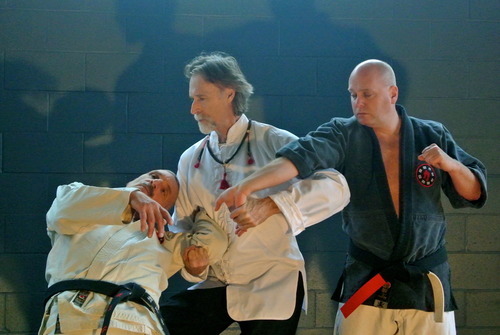
CHRONICLES OF
THE DOKA
#20 in a continuing series— 84 days in the teaching life of an
American sensei in 1999, real people-real study
Police
officer Mitchell, approaches me at the front of the room as I lay my black
leather briefcase in the far left corner. He reminds me of an ancient Night
Templar.
“Sensei,” he announces respectfully, “I have
two problems. “The first, I forgot your money for the wrist- wrap gloves. The
second, I broke the Sports Flex.”
Mitch
had ordered a stretching machine and had picked it up recently from my house.
Mitch weighs in at an imposing two-hundred
plus pounds, a good weight for a Night Templar and Sports Flex destroyer.
“Ah! The two inevitable consequences of
life,” I tell him. “Things break and people are forgetful. You can pay next
week for the gloves and I will replace your stretching machine.” I’ve been a
sales rep for Century Martial Arts in Oklahoma for decades. They will exchange
his broken device for a new one, no questions asked.
“Also,” Mitch continues, “I got a book in
the mail— Dillman’s pressure points. It has as section on Neihanchi Kata.”
Mitch posed this last piece of information as a probe to see if I was familiar
with it. Mitch is half way through the Neihanchi form in his current training.
A common problem confronting martial
teachers today is the enormous availability of martial information at a
student’s fingeRtips from outside the
dojo. Sometimes, the pacing and the placing of information gets distorted, even
misaligned if a student is plugged into too many learning conduits at one time.
Today’s martial arts teacher is being slowly undermined by the rise of these peripheral
media and electronic teaching mediums. We are seeing a gradual homogenization
of American martial teachers as a result. In the future we may see every dojo
selling the same mixed bag of services. It’s what I call the ‘Mall syndrome.’
Every mall in the U.S. starts to look the same. Same stores. Nothing unique or
creative.
I had
a student once who had arranged a private lesson with me in which I was going
to introduce him to the kata wansu. I
had been pacing his progress and was looking forward to working with him on the
new material. When he entered the dojo, I told him, “Today, we will start the wansu kata.” I thought he would be excited.
Instead he eagerly stated, “I already know it!”
“How so?” I asked, somewhat taken aback.
“I found an isshinryu video advertised in
Inside Karate Magazine. I bought it
and memorized the form.”
I admired him for his enthusiasm. But I
told him, “You’ll need to decide who you want as your teacher. If you want to
learn from a video that’s fine by me. But I will no longer instruct you.” You
know what they say, “too many cooks in the kitchen spoil the broth.” The
student stopped purchasing kata videos and did quite well in his studies.
Good
teachers who know their art will get you where you need to go. It’s not helpful
to suggest to them other routes and pacing when they possess that very skill.
It simply creates confusion. On the other hand there is nothing wrong with
bringing up a discussion about the differences in training methods from school
to school. Knowledgeable sensei ought to be able to give you the logic why you
are being taught in the manner they have chosen.
